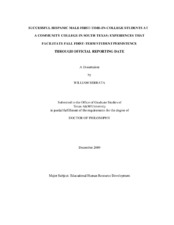| dc.contributor.advisor | Dooley, Larry M. | |
| dc.creator | Serrata, William | |
| dc.date.accessioned | 2011-02-22T22:24:03Z | |
| dc.date.accessioned | 2011-02-22T23:47:17Z | |
| dc.date.available | 2011-02-22T22:24:03Z | |
| dc.date.available | 2011-02-22T23:47:17Z | |
| dc.date.created | 2009-12 | |
| dc.date.issued | 2011-02-22 | |
| dc.date.submitted | December 2009 | |
| dc.identifier.uri | https://hdl.handle.net/1969.1/ETD-TAMU-2009-12-7506 | |
| dc.description.abstract | The Hispanic population continues to rapidly increase within the state of Texas
as well as the nation. However, the Hispanic population educational attainment level
lags behind that of the general population. Hispanic males are the lowest educated
segment of society averaging less than a high school diploma. The negative long-term
economic impact of such low educational attainment levels coupled with the rapid
increase of the Hispanic population has been documented by Texas state demographers
as well as the U.S. Census Bureau.
The researcher conducted a qualitative study to inform a deeper understanding of
the experiences that facilitated the persistence of 18 Hispanic male first-time-in-college
students through the official reporting date of their fall first termat a community college
in South Texas. An asset model and related conceptual framework, which recognized
students as experts, were utilized. Focus group interviews, semi-structured interviews,
and existing data were analyzed utilizing qualitative research methods.
The researcher identified six overarching themes that significantly influenced the
students? ability to persist. In addition, analysis of the data produced five barrier themes
that these students overcame via the utilization of corresponding knowledge and actions
themes. Finally, students provided recommended college changes for mitigating the
barriers faced by future Hispanic male students.
The researcher provided conclusions regarding Hispanic male students,
recommendations for students, recommendations for colleges and universities serving
Hispanic male students, recommendations for the focal community college, and
implications for the theoretical model utilized. The researcher recommended expanding
this research to other institutions of higher education and notes the national implications
for increasing the educational attainment level of Hispanic male students. | en |
| dc.format.mimetype | application/pdf | |
| dc.language.iso | en_US | |
| dc.subject | Hispanic Male | en |
| dc.subject | First-time-in-college | en |
| dc.subject | Student Success | en |
| dc.subject | Persistence | en |
| dc.subject | Asset Model | en |
| dc.subject | Barriers | en |
| dc.subject | Retention | en |
| dc.subject | Withdrawal Rate | en |
| dc.title | Successful Hispanic Male First-Time-In-College Students at a Community College in South Texas: Experiences That Facilitate Fall First-Term Student Persistence Through Official Reporting Date | en |
| dc.type | Book | en |
| dc.type | Thesis | en |
| thesis.degree.department | Educational Administration and Human Resource Development | en |
| thesis.degree.discipline | Educational Human Resource Development | en |
| thesis.degree.grantor | Texas A&M University | en |
| thesis.degree.name | Doctor of Philosophy | en |
| thesis.degree.level | Doctoral | en |
| dc.contributor.committeeMember | Nafukho, Fredrick | |
| dc.contributor.committeeMember | Tolson, Homer | |
| dc.contributor.committeeMember | Lindner, James | |
| dc.type.genre | Electronic Dissertation | en |
| dc.type.material | text | en |


